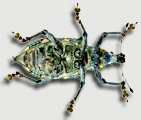Citation:
Date Published:
Apr 28Abstract:
The extraordinary diversity of herbivorous beetles is usually attributed to coevolution with angiosperms. However, the degree and nature of contemporaneity in beetle and angiosperm diversification remain unclear. Here we present a large-scale molecular phylogeny for weevils (herbivorous beetles in the superfamily Curculionoidea), one of the most diverse lineages of insects, based on approximate to 8 kilobases of DNA sequence data from a worldwide sample including all families and subfamilies. Estimated divergence times derived from the combined molecular and fossil data indicate diversification into most families occurred on gymnosperms in the Jurassic, beginning approximate to 166 Ma. Subsequent colonization of early crown-group angiosperms occurred during the Early Cretaceous, but this alone evidently did not lead to an immediate and major diversification event in weevils. Comparative trends in weevil diversification and angiosperm dominance reveal that massive diversification began in the mid-Cretaceous (ca. 112.0 to 93.5 Ma), when angiosperms first rose to widespread floristic dominance. These and other evidence suggest a deep and complex history of coevolution between weevils and angiosperms, including codiversification, resource tracking, and sequential evolution.
